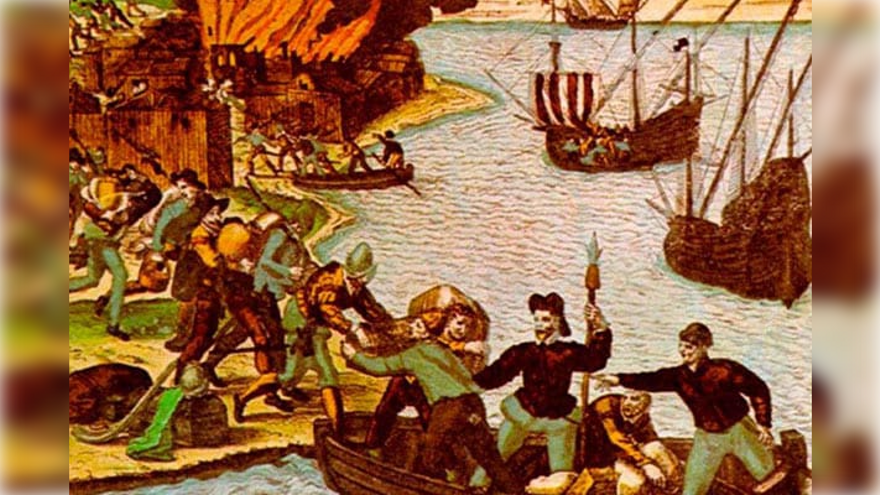
14ymedio, Yunior García Aguilera, Madrid, 4 July 2023 – Laws that restrict business to an absurd extent usually generate corruption and all manner of roguery. Following the Conquest and colonisation of the Americas, the maritime powers established a commercial system that created an exclusive relationship between the metropolises and their colonies. Trading with foreigners carried the penalty of a jail sentence, excommunication and confiscation of assets. This measure affected the colonies most of all but it also promoted smuggling and filled the seas with plunderers.
It all started with a few French vessels laying siege to the fleets which arrived in the Canary Islands. Later, these sailors got hold of the Spanish navigation charts and approached the waters of the Caribbean. England, France and Holland saw such substantial gains in these sorts of ventures that they began to invest their own funds in the business. It was the heyday of the black flags with the skulls and crossbones.
As opposed to ordinary pirates, these pirates relied on permission from some country or other to attack and rob from their rivals. When two kingdoms were at war, the offender had to be treated as an enemy soldier, with all the guarantees that implied. In times of peace it was assumed that these pirates had to respect the truce, although the soul of a pirate will nonetheless grant himself a blank cheque to never take this sort of thing seriously.
The buccaneers, for their part, were a kind of pirate of terra firma. The term búcan was the Tainos word for the technique of smoking meat. Many Europeans learnt how to use these skills; they dedicated themselves to smuggling and adopted the name of buccaneers. In Cuba they were mostly to be found in areas like Camagüey and Las Tunas.
The fledgling Cuban population were victims of pirate assaults on a number of occasions. It’s known that Havana was reduced to ashes in 1538. And in the same year, outside the port of Santiago, the Sevillian captain Diego Pérez battled a French pirate for four days. By day they attacked mercilessly with canon fire. And by night they sent messengers bearing gifts, like good Christian gentlemen, until the French lifted anchor and bid them adieu.
But the most famous attack took place on the tenth of July 1555, led by Jacque de Sores. Ten years earlier, San Cristobal de La Habana was defended by a single canon of 47 hundredweight which they nicknamed “the savage”, evidence of which had been accompanied by exaggeration and ostentation from an early stage. Later the place was “fortified” until it had three canons. At the time of the attack, the governor was Pérez de Angulo, who defended Havana with 65 foot soldiers and 16 others on horseback.
As soon as the French pirate – follower of the famous Pegleg – returned to dry land, Angulo ran terrified to the yucayeque of Guanabacoa. However, the governor, Don Juan de Lobera, stood his ground the best could, defending from the old Fort.
But there wasn’t a great deal of courage in this resistance. Some of his men suggested he surrender, telling him that he could die if he wanted to but he wasn’t going to sacrifice all the others. Sores himself asked who was the madman that was trying to defend Havana with four crossbows. One of his artillerymen even went to negotiate with the pirates, speaking to them in German so that Juan wouldn’t understand a word.
Finally, the pirate conquered the place, although he didn’t find the riches he was hoping for, apart from an emerald ring and a silver dinner service. The Frenchman took hostages and demanded 30 thousand pesos in ransom…as well as some cassava bread loaves! He spared the brave defender’s life and promised not to molest the women.
Angulo, in a final attempt to save his honour, gathered an army together at Matanzas… no exaggeration. There were 95 Spanish, some 200 Africans and around 80 indigenous men. The element of surprise was a key factor, but the indigenous men, who were used to attacking with ferocious noise, alerted the French with their shouting and it was a disaster. The pirate swords repelled the attempt and Havana continued to be under French rule for a few more days.
As a counter-offer, three thousand pesos ransom was offered. However, the inhabitants only managed to get together one third of the amount. Sores, outraged in the face of such destitution (or miserliness), set fire to everything that could be burnt. Angulo was sent to Spain and was tried for cowardice and lack of foresight. He was the last of the civilian governors.
Today, centuries later, buccaneering still survives. And in Cuba many have permission to practice it, which, technically… turns them into pirates?
Translated by Ricardo Recluso
____________
COLLABORATE WITH OUR WORK: The 14ymedio team is committed to practicing serious journalism that reflects Cuba’s reality in all its depth. Thank you for joining us on this long journey. We invite you to continue supporting us by becoming a member of 14ymedio now. Together we can continue transforming journalism in Cuba.
